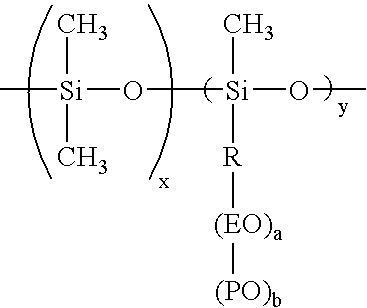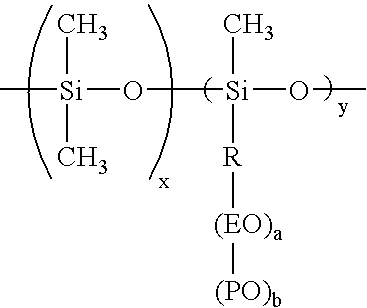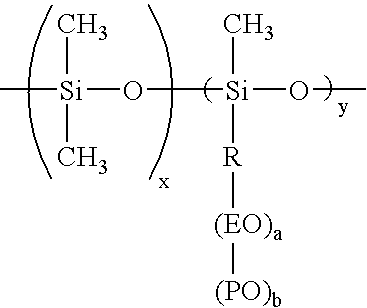Aqueous ink
a technology of aqueous ink and ink, applied in the field of aqueous ink, can solve the problems of inferior storage stability of aqueous ink, easy occurrence of adsorption-desorption, and difficulty in stably keeping this dispersed state, and achieve excellent improve fixability and ejection stability, and improve print quality
- Summary
- Abstract
- Description
- Claims
- Application Information
AI Technical Summary
Benefits of technology
Problems solved by technology
Method used
Image
Examples
example 1
(1) Production of Dispersion: Dispersion 1
[0121] For the production of dispersion 1 used in Example 1, Color Black S170 (manufactured by Degussa-Huels AG), a carbon black pigment which is an inorganic pigment, was used.
[0122] First, the internal atmosphere of a reaction vessel equipped with a stirrer, a thermometer, a reflux condenser and a dropping funnel was replaced with nitrogen, and then, 22 parts of styrene, 5 parts of α-methylstyrene, 15 parts of butyl methacrylate, 10 parts of lauryl methacrylate, 2.5 parts of acrylic acid and 0.3 part of t-dodecylmercaptan were put therein, followed by heating at 70° C. Then, 150 parts of styrene, 15 parts of acrylic acid, 50 parts of butyl methacrylate, 1 part of t-dodecylmercaptan, 20 parts of methyl ethyl ketone and 3 parts of azobisisobutyronitrile separately prepared were put in the dropping funnel, and added dropwise to the reaction vessel, taking 4 hours, to conduct polymerization reaction, thereby obtaining a dispersing polymer. ...
example 2
(1) Production of Dispersion: Dispersion 2
[0155] For the production of dispersion 2 used in Example 2, an insoluble monoazo yellow pigment (C.I. Pigment Yellow 74) which is an organic pigment was used. Except for that, dispersion 2 containing dispersion 2 (a dispersion in which the insoluble monoazo yellow pigment was encapsulated with the polymer having an aromatic ring amount of 25%) in an amount of 20% was obtained in the same manner as in Example 1 (1) described above, but by a method in which synthesis conditions of the polymer were somewhat changed.
[0156] The pigment / polymer ratio in dispersion 2 was measured in the same manner as in Example 1 (1) by the method described in the above-mentioned “Measurement of Pigment / Polymer Ratio”. As a result, it was 75:25.
(2) Preparation of Ink
[0157] In Example 2, there were used dispersion 2 obtained in Example 2 (1) described above, SH-3772M (manufactured by Dow Corning Toray Silicone Co., Ltd.; HLB value=6), an EO-modified silicone...
example 3
(1) Production of Dispersion: Dispersion 3
[0164] For the production of dispersion 3 used in Example 3, a quinacridone magenta pigment (C.I. Pigment Magenta 122) which is an organic pigment was used. Except for that, dispersion 3 containing dispersion 3 (a dispersion in which the quinacridone magenta pigment was encapsulated with the polymer having an aromatic ring amount of 25%) in an amount of 20% was obtained in the same manner as in Example 1 (1) described above, but by a method in which synthesis conditions of the polymer were somewhat changed.
[0165] The pigment / polymer ratio in dispersion 3 was measured in the same manner as in Example 1 (1) by the method described in the above-mentioned “Measurement of Pigment / Polymer Ratio”. As a result, it was 75:25.
(2) Preparation of Ink
[0166] In Example 3, there were used dispersion 3 obtained in Example 3 (1) described above, SH-3773M (manufactured by Dow Corning Toray Silicone Co., Ltd.; HLB value=8), an EO-modified silicone, Surfy...
PUM
| Property | Measurement | Unit |
|---|---|---|
| particle size | aaaaa | aaaaa |
| particle size | aaaaa | aaaaa |
| particle size | aaaaa | aaaaa |
Abstract
Description
Claims
Application Information
 Login to View More
Login to View More - R&D
- Intellectual Property
- Life Sciences
- Materials
- Tech Scout
- Unparalleled Data Quality
- Higher Quality Content
- 60% Fewer Hallucinations
Browse by: Latest US Patents, China's latest patents, Technical Efficacy Thesaurus, Application Domain, Technology Topic, Popular Technical Reports.
© 2025 PatSnap. All rights reserved.Legal|Privacy policy|Modern Slavery Act Transparency Statement|Sitemap|About US| Contact US: help@patsnap.com



